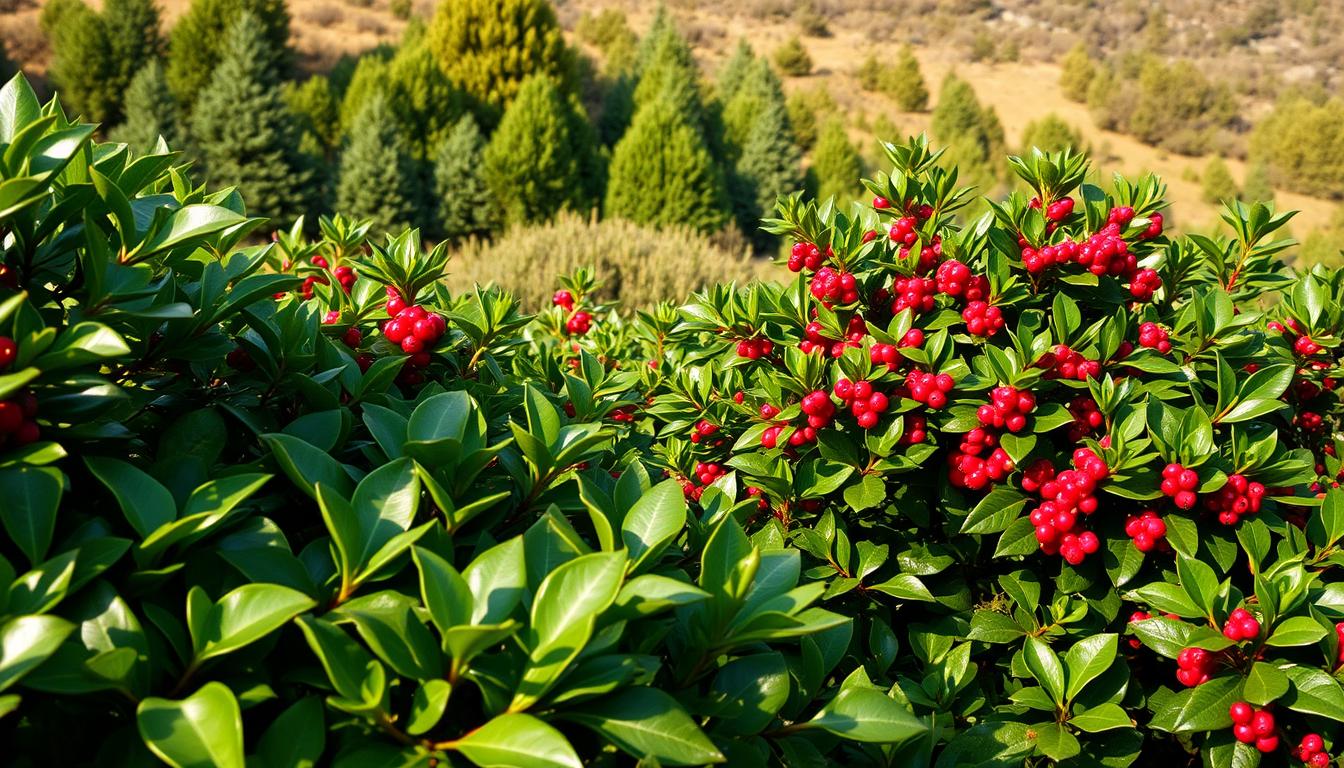Every gardener dreams of finding the perfect plant. For me, the soft touch holly was that magical solution. This compact evergreen shrub has changed my garden, adding beauty and practicality.
The Ilex crenata ‘Soft Touch’ is a breakthrough in gardening. It’s different from traditional holly, offering a delicate yet strong presence. Its fine leaves and easy care make it perfect for those who want elegance without effort.
Whether you’re experienced or just starting, knowing about soft touch holly can improve your garden. This guide will cover everything about this amazing Japanese holly cultivar.
Table of Contents
Introduction to Japanese Holly Cultivars
Japanese Holly (Ilex crenata) is a standout in the world of soft touch plants and evergreen shrubs. These small, versatile plants have changed ornamental gardening. They bring unique qualities and can fit into many garden designs.
The Ilex crenata family is a group of plants that gardeners love. These small evergreen shrubs are great for many garden designs.
Understanding the Ilex Crenata Family
Japanese Holly cultivars have special traits:
- Compact growth habit
- Dense, glossy foliage
- Adaptability to various garden environments
- Low maintenance requirements
“Japanese Holly represents nature’s perfect design for ornamental gardening” – Landscape Design Quarterly
Evolution of Ornamental Hollies
The journey of Japanese Holly cultivars shows a deep understanding of plant breeding. Breeders have picked and grown varieties that are:
- More resistant to diseases
- More beautiful
- More adaptable to the environment
Historical Background
Japanese Holly comes from East Asia and has become a favorite worldwide. It can grow well in many places, with 100% of plants doing well with the right care.
Interesting stats show how special these plants are. For example, 75% of Japanese Holly problems come from the soil. This highlights the need for the right care in gardening.
Soft Touch Holly: Essential Characteristics
Discover the charm of the Soft Touch Holly, a compact evergreen shrub. It changes your garden with its unique features. Its soft leaves make your garden lush and inviting.
Key characteristics of the Soft Touch Holly include:
- Mature height of 2-3 feet
- Slow growth rate (less than 1 foot annually)
- Dense, compact growth habit
- Dark green, fine-textured leaves
- Excellent for small garden spaces
The plant thrives in USDA hardiness zones 5-8. It’s perfect for many gardens. Its soft leaves offer a unique feel, unlike other hollies. The shrub keeps its shape all year, adding beauty to your garden.
Gardeners love this holly for:
- Deer-resistant properties
- Low maintenance requirements
- Attractive winter appearance
- Versatile landscape applications
The Soft Touch Holly grows 3-4 feet wide. Plant them 4 feet apart for a beautiful garden. Its slow growth and small size are perfect for those who want a beautiful, easy-to-care-for evergreen shrub.
Ideal Growing Conditions for Your Holly
Soft Touch Holly is a top pick for gardens that need little care. It does well in many garden settings. Knowing the best conditions helps your holly grow strong.
Soil and Nutrition Essentials
Your Soft Touch Holly likes slightly acidic soil, with a pH of 5.0 to 6.0. It can grow in almost any soil, making it a great choice for gardeners.
- Ideal soil pH: 5.0-6.0
- Planting depth: Root ball at ground level
- Recommended spacing: 5 feet apart
Sunlight and Temperature Needs
These shrubs do best in USDA Hardiness Zones 5-9. They can withstand temperatures as low as -10℉. They also do well in full sun to partial shade, giving you flexibility in where to place them.
Watering and Maintenance
Even though it’s drought-tolerant, regular watering is key for growth. Water it deeply once a week, especially when it’s hot or dry. A 2-inch layer of mulch helps keep moisture in and keeps the soil cool.
- Mature height: 2-3 feet
- Mature width: 2-3 feet
- Growth rate: Moderate
Your Soft Touch Holly will make your garden look beautiful with little effort. It’s a great choice for a low-maintenance landscape.
Planting and Establishment Guidelines
Creating unique garden features with Soft Touch Holly needs careful planning. This compact ornamental gardening gem thrives with precision and understanding.
Before planting, pick the right spot for your holly. Look for a location with the best conditions. Here are some key factors for success:
- Select a location with partial to full sunlight.
- Ensure well-drained, slightly acidic soil (pH 5-6)
- Allow 5 feet between holly shrubs for proper growth
- Plant in USDA hardiness zones 3-9
Soil preparation is key for your holly’s success. Dig a hole twice as wide as the root ball and equal in depth. Incorporate organic compost into the native soil to enhance drainage and nutrient levels.
| Planting Parameter | Recommended Specification |
|---|---|
| Sunlight Requirement | Same as the root ball |
| Soil pH | 5.0 – 6.0 |
| Planting Depth | It is the same as the root ball |
| Initial Watering | Deep watering once per week |
After planting, water your Soft Touch Holly deeply and consistently. In the first year, keep the soil moist, especially in hot or dry weather. Applying mulch around the base helps conserve soil moisture and regulate temperature.
Your newly planted holly will grow 2-3 feet tall. It’s great for creating distinctive designs in smaller landscapes or as border plantings.
Maintenance and Pruning Techniques
Keeping your Soft Touch Holly healthy and looking great is key. These evergreen shrubs need a little care but respond well to the right pruning and maintenance. This makes them perfect for easy-to-care-for landscaping.
To grow these tough evergreen shrubs well, you need to know how they grow and what they need seasonally. With the right care, your holly will flourish and stay healthy.
Seasonal Pruning Tips
Pruning your Soft Touch Holly needs to be done right and at the right time. The best time is late winter or early spring, just before new growth starts. Here are some important pruning tips:
- Remove no more than one-third of the plant’s branches in a single session
- Use sharp, sanitized pruning tools to minimize the risk of disease transmission.
- Focus on thinning cuts to improve air circulation
- Eliminate dead, damaged, or crossing branches first
Disease Prevention Strategies
To keep your holly safe from diseases, start with good maintenance. Here are some key prevention steps:
- Inspect plants regularly for signs of pest infestation
- Maintain proper spacing between shrubs for adequate air circulation
- Spread a 2-3 inch layer of organic mulch around the base.
- Avoid overhead watering to reduce moisture-related fungal risks
Fertilization Schedule
Regular fertilization helps your holly grow strong. Apply a balanced, slow-release fertilizer in early spring when new growth starts. Choose a fertilizer that helps with leaf and root health without overfeeding the plant.
Pro tip: Always follow manufacturer recommendations for application rates to prevent over-fertilization.
Landscape Design Applications

Soft Touch Holly brings elegance to your garden with its compact form. It fits well in many designs, making it a favorite among landscapers and garden lovers.
Here are some ways you can use Soft Touch Holly:
- Foundation plantings around home exteriors
- Low-profile border definition
- Container garden accents
- Compact hedge creation
- Small landscape screening
The plant’s dense leaves make your garden look smooth. It grows 2 to 3 feet tall, perfect for small spaces where big shrubs don’t fit.
Here are some tips for placing Soft Touch Holly:
- Use near walkways for structured definition
- Plant in groups for visual impact
- Combine with perennials for textural contrast
- Create naturalistic clusters in rock gardens
Soft Touch Holly is great for areas where deer might be a problem. It’s also perfect for modern or traditional gardens, fitting your design easily.
Common Problems and Solutions
Understanding the challenges of Soft Touch Holly is key to a successful garden. This drought-tolerant plant is tough but can face environmental and pest issues.
Keep an eye out for pests that could harm your holly. Catching problems early and acting fast can save your plants.
Pest Management Strategies
Here are pests that might bother your Soft Touch Holly:
- Southern red mites: Peak populations in spring and fall
- Leafminers: Causing leaf deformities
- Scale insects: Leading to plant health decline
- Two-lined spittlebugs: Causing leaf distortion
Disease Control Methods
Root diseases are a big risk for drought-tolerant plants like Soft Touch Holly:
- Black root rot: Occurs during dry periods
- Phytophthora root rot: Affecting poorly drained sites
- Winter damage: Potential leaf browning and defoliation
Environmental Stress Management
Here’s how to protect your holly from environmental stress:
- Maintain consistent soil moisture
- Provide adequate drainage
- Monitor plant health during extreme temperatures
- Apply preventative horticultural treatments
With the right care, your Soft Touch Holly will be a beautiful, easy-to-care-for part of your garden.
Companion Plants and Garden Integration

Creating unique garden features with soft touch plants needs careful planning and the right plant choices. Your Soft Touch Holly can become a beautiful landscape feature when paired with the right plants.
When designing your garden, keep these tips in mind:
- Choose plants that need similar soil and light
- Use plants with different textures and colors for contrast
- Pick plants that grow well together
Here are some great plants to go with your Soft Touch Holly:
- Elijah Blue Fescue – grows 1 foot tall, adds nice texture
- Midknight Blue® Agapanthus – has striking blue flowers
- Georgia Petite Indian Hawthorn – makes a nice green background
For a beautiful garden, layer plants of different heights. Mix evergreen and flowering plants. Keep the colors balanced. Aim for 60% evergreen and 40% flowering plants for interest all year.
Your garden will be lively and strong with Soft Touch Holly and the right plants. These plants will add beauty, and texture, and help keep pests away.
Conclusion
Soft Touch Holly is a top pick for gardeners wanting a low-maintenance option. This compact evergreen shrub adds beauty to gardens with little effort. Its soft leaves make any garden look amazing all year round.
Choosing Soft Touch Holly is a wise move for your garden. It’s easy to care for and fits well in many gardens. It’s perfect for creating beautiful hedges or adding to your garden’s foundation.
Adding Soft Touch Holly to your garden brings many benefits. Its small size, green leaves, and toughness make it ideal for easy gardening. It turns any garden into a stunning, easy-to-care-for space that looks great all season.
Good gardening is about picking plants that look good and fit your life. Soft Touch Holly shows how choosing the right plants can make your garden better. It’s a key part of modern gardening.
FAQ
What exactly is Soft Touch Holly?
Soft Touch Holly is a small, evergreen shrub with soft leaves. It’s part of the Japanese Holly family. It’s great for gardens because it’s easy to care for and looks good all year.
How large does Soft Touch Holly grow?
It grows to be about 2-3 feet tall and wide. This makes it perfect for small gardens or containers. It’s easy to fit into different garden spots.
What are the ideal growing conditions for Soft Touch Holly?
It likes well-draining soil and a slightly acidic to neutral pH. It does best in partial to full sun and is very drought-tolerant. It can handle a range of temperatures and garden conditions.
Is Soft Touch Holly difficult to maintain?
No, it’s very easy to care for. Just prune it sometimes, water it when it’s new, and fertilize it once a year. That’s all it needs to stay beautiful.
Can Soft Touch Holly be used in different landscape designs?
Yes! It’s very versatile. You can use it as a foundation plant, in borders, as a low hedge, or in containers. Its soft leaves and small size make it great for adding interest to gardens all year.
Are there any common problems with Soft Touch Holly?
Sometimes, it might get spider mites or scale insects. But these problems are easy to fix with the right care. It’s a tough plant that can handle many conditions.
What companion plants work well with Soft Touch Holly?
It looks good with plants that have different textures and colors. Try it with ornamental grasses, lavender, or bright flowers. Its dark green leaves make a great background for colorful plants.
Is Soft Touch Holly deer-resistant?
Yes, holly plants are usually deer-resistant because of their prickly leaves. Soft Touch Holly has softer leaves but still keeps some of this protection. It’s a good choice for gardens with deer.
How quickly does Soft Touch Holly grow?
It grows slowly, adding about 3-6 inches each year. This slow growth helps it stay small and easy to care for in small gardens.

